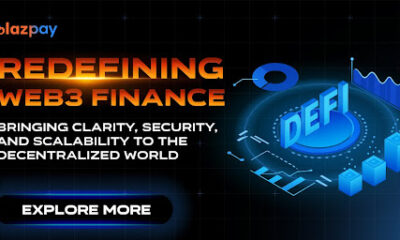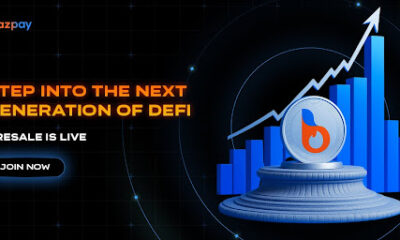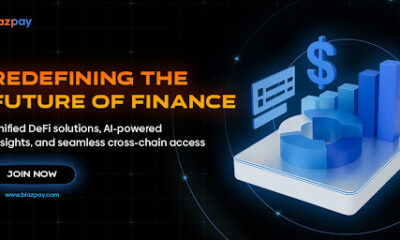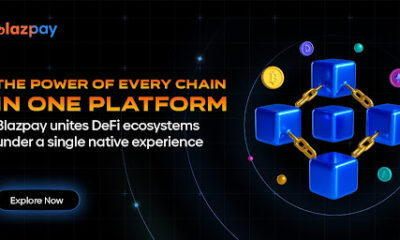Crypto
4 Best Altcoins for 2025: Cold Wallet, Solana, SUI & Hedera Set For Big Gains
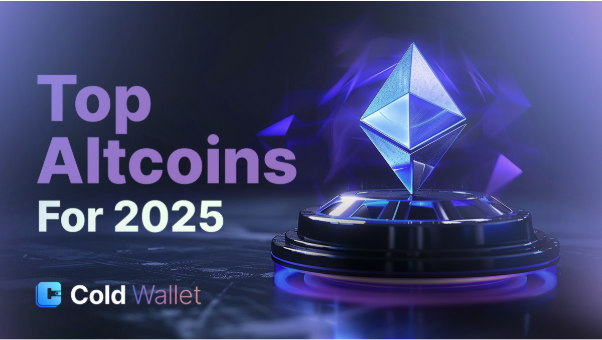
The fast-changing crypto space is filled with new launches almost every day, yet only a few manage to show lasting strength. Many fade after initial hype, leaving traders searching for projects with real use and solid earning potential. For those aiming to spot opportunities early, separating long-term contenders from short-lived trends is not easy.
This list focuses on four names that showed strong traction in July: Cold Wallet, Solana, SUI, and Hedera. Each has a unique approach but all carry notable upside as the year moves forward. From scaling tech to enterprise-grade adoption, these projects offer a clear look at some of the best altcoins for 2025 in today’s market.
1. Cold Wallet: Expanding Fast With A $270M Advantage
Cold Wallet is moving away from the standard wallet model, which is why it has become one of the most talked-about names in the market today. Instead of simply storing digital assets, it rewards ongoing activity. Every swap, ramp, and bridge made through the platform earns cashback in CWT, its native coin. On top of this, it offers a referral program and a tiered cashback system that can boost earnings even more for active participants.
The response has been strong. In just a few weeks, the project has raised over $5.7M, with 643.72 million coins sold. It is now in Stage 16 with a current price of $0.00924. A confirmed listing at $0.3517 translates into an impressive overall ROI of 4900%. Those joining at the current $0.00942 level could potentially see returns of about 3,700% if it reaches that listing price.
Fueling this momentum is the $270M acquisition of Plus Wallet, a move that instantly combined user bases and expanded market reach. This integration not only adds scale but also signals a long-term growth strategy rather than chasing short-term hype.
With its focus on utility, generous reward structure, and strategic acquisition, Cold Wallet (CWT) stands out in a crowded field. It combines high earning potential with a solid plan for expansion, making it one of the best altcoins for 2025 to keep in focus during this cycle. The mix of strong fundamentals and clear scaling moves positions it as a serious contender for continued growth.
2. Solana: High-Speed Layer 1 Leader
Solana remains a top contender in the crypto space, trading at $169.45. It has recovered from earlier challenges and now runs as one of the most active chains. Fast speeds and low fees make it popular for NFTs, DeFi, and other high-volume use cases.
Daily activity is steady, and developer interest stays strong. In some areas, it matches Ethereum’s usage but without high costs. Projects like Stepn, Helium, and Jupiter Exchange continue to choose Solana, adding depth to its network. This growth and adoption keep Solana firmly in the conversation when discussing the best altcoins for 2025 in the current market.
3. SUI: A New Home For Builders
At $0.77, SUI is quickly building a name as a fresh Layer 1 designed for speed and usability. Developed by Mysten Labs and using the Move programming language, it gives builders flexibility and control for creating dApps.
Its standout features are already attracting attention in lending, gaming, and DeFi solutions. Total value locked keeps climbing, and new product launches bring in steady activity. While smaller compared to Solana or Ethereum, this early stage offers room for strong growth. SUI’s momentum and developer appeal place it among the best altcoins for 2025 to watch closely.
4. Hedera: Driving Enterprise-Grade Adoption
Hedera (HBAR), priced at $0.078, stands out for real-world adoption, especially with large enterprises. Using Hashgraph rather than traditional blockchain, it delivers fast speeds, fixed low fees, and low energy use.
This design makes it appealing for sectors like healthcare, identity management, and supply chains. Companies such as Google, Dell, and IBM are already linked to its progress, with a growing Governing Council providing further credibility. This combination of enterprise support and efficient tech keeps Hedera in the mix when discussing the best altcoins for 2025 with practical applications.
Summing Up!
Solana’s speed, low costs, and strong developer activity give it a clear edge in the Layer 1 race. SUI’s early growth stage and DeFi-friendly tools make it a chain with big upside. Hedera’s enterprise partnerships and real-world use cases secure its position in the market.
Still, for sheer profit potential, Cold Wallet is hard to overlook. Now at Stage 16 with a current price of $0.00924, a listing target of $0.3517, and an ROI of 4900%, it offers a rare high-reward setup. The $270M Plus Wallet merger strengthens its base more than many older projects still chasing scale. With each stage lifting its price, timing remains key, making it one of the best altcoins for 2025 to track going forward.
Crypto
Vitalik Buterin Offloads STRAYDOG as Team Initiates Buybacks and Strategic Token Burn Plan

Ethereum founder Vitalik Buterin sold STRAYDOG tokens over the past twenty four hours according to on chain data. The tokens were originally received via airdrop from community and team nearly four months ago.
The sale occurred near recent price lows during a broader period of market weakness. Similar sales by Buterin in past cycles have often coincided with shifts in market attention rather than extended downside.
Following the transaction STRAYDOG team began purchasing tokens on the open market. The team confirmed that purchased tokens will be allocated toward a future burn.
According to the team two hundred thousand dollars worth of bought STRAYDOG tokens will be burned once the token reaches a ten million dollar market capitalization reducing circulating supply.
Market participants are now watching on chain activity as the project approaches the announced milestone.
The project maintains a fat treasury valued at hundreds of thousand of dollars, enabling the development team to continue conducting ongoing buybacks rather than a one time purchase. The team also stated that it plans to burn $200,000 worth of bought STRAYDOG tokens at every additional $10 million increase in market capitalization, further reducing circulating supply over time.
Telegram – t.me/StrayDogETH
Website –www.straydogcoin.com
Book on amazon –https://a.co/d/3nzCtUp
Crypto
Marshall Islands Turn to Digital Assets to Expand Financial Access

The Republic of the Marshall Islands is taking a major step toward digital transformation, piloting a blockchain-based system to distribute universal basic income (UBI). The initiative aims to reduce the nation’s dependence on physical cash and address long-standing financial access issues across its remote island communities.
A move from paper checks to digital wallets
During the latest payout cycle, Marshallese citizens received their UBI in two different ways. Some continued using traditional paper checks issued through the Economic and Natural Resources Authority. Others, however, received funds digitally through Lomalo, a citizen wallet built on the Stellar blockchain.
The digital payments were delivered in USDM1, a government-designed token intended to act as a sovereign financial instrument rather than a typical stablecoin. Unlike most stablecoins—where yield flows to the issuer—USDM1 functions similarly to a government-backed money market asset, generating returns directly for the holder.
This structure is meant to stabilize the token’s value and distance it from the volatility seen in assets such as Bitcoin, while still enabling everyday payments.
A wallet built for mass adoption
Despite improvements in internet connectivity through satellite providers such as Starlink, daily commerce in the Marshall Islands still depends heavily on physical cash. Cash shipments arrive by boat, and delays can lead to temporary shortages, limiting residents’ ability to transact or access money.
Digital delivery through Lomalo is designed to change that. Payments can be sent instantly across the islands without relying on cash deliveries or a fragile physical banking network. The wallet also strips away the typical technical complexity associated with crypto applications. Crypto infrastructure firm Crossmint manages the onboarding process, enabling citizens to use digital funds without understanding private keys or blockchain mechanics.
The broader push toward digital assets also reflects the country’s challenging financial reality. In the years following the 2008 global financial crisis, many foreign banks exited the region over compliance and risk concerns. That exodus left the Marshall Islands with just one correspondent banking partner—creating a vulnerability for everything from international transfers to local business operations.
USDM1 offers an alternative pathway by reducing reliance on traditional bank channels and giving residents an additional method to store and access funds.
Part of a wider global strategy
The Marshall Islands pilot is one component of a larger effort led by the Stellar Development Fund to expand financial access in underserved regions. The organization has allocated several million dollars to support the USDM1 initiative.
The approach builds on previous projects that facilitated humanitarian payments, including salary distributions for healthcare workers in conflict zones and cash-assistance programs run with NGOs. Lessons learned from partnerships with the Ukrainian government and international aid groups helped refine the system now being tested in the Marshall Islands.
Across all these programs, the core goal remains the same: ensuring individuals—not intermediaries—have direct control over their digital assets, while improving access to reliable financial infrastructure.
Crypto
Why Is Midnight (NIGHT) Price Pumping Hard?

The Midnight (NIGHT) price has surged to the top of the market leaderboard, jumping roughly 30% in a single session and trading around $0.0866 at the time of writing. The rally isn’t happening in isolation. Trading volume has spiked nearly 70%, signaling genuine market participation rather than a temporary liquidity anomaly. As a result, the NIGHT token has become one of the day’s strongest performers, attracting attention both inside and beyond Cardano’s ecosystem.
A mix of partnership speculation, regulatory narratives, and a clean technical breakout is driving the current Midnight price momentum and helping push the asset into a new phase of price discovery.
A key catalyst behind the Midnight price pump is rising speculation about a potential stablecoin partnership. Midnight Foundation President Fahmi Syed confirmed that the team has received a legal contract from a prospective partner—an indication that talks have moved past preliminary stages. For traders, this was enough to begin pricing in the possibility of compliant stablecoin infrastructure built directly on Midnight’s privacy-focused network.
Given how central stablecoins are to liquidity, payments, and on-chain activity, the idea of a regulated privacy chain supporting compliant stablecoin integrations has fueled bullish sentiment around the NIGHT token.
Regulatory dynamics in the EU are adding further weight to the rally. New proposals targeting anonymous transactions and digital identity verification have renewed interest in privacy solutions built for regulated environments. Midnight’s selective disclosure model—which enables verification without exposing full personal data—positions it as a potential middle ground between transparent blockchains and traditional privacy coins.
While regulatory frameworks remain in flux, the environment favors projects that can offer compliance-ready privacy. For now, the Midnight crypto narrative fits that trend.
The surge in NIGHT trading activity shows the rally is not merely social-media driven. At one point, Midnight ranked among the top five assets globally by trading volume, a signal that demand is broad instead of concentrated in a single community. Sustaining high volume will be essential if the recent price move is to evolve into a longer-term trend. Sharp increases without follow-through often lead to quick reversals or sideways consolidation.
On the technical front, the Midnight price has delivered a clean breakout. On the 1-hour chart, NIGHT pushed above its long-standing consolidation band between $0.060 and $0.065, a range that repeatedly capped upside attempts. The breakout happened on rising volume—a strong confirmation signal—and the chart has since produced a series of higher highs and higher lows.
Analytics platform TapTools described the current phase as “entering price discovery,” reflecting the lack of historical resistance overhead. With no clear prior supply zones, movement is now primarily driven by momentum, trader positioning, and incoming news flows.
From a structural perspective, the key support level to watch is the former breakout zone around $0.070. As long as the Midnight price stays above that threshold, short-term momentum remains strongly bullish. Losing that level could open the door to consolidation or a retest of lower support, especially if trading volume begins to fade.
In the short term, upside continuation for the NIGHT token depends heavily on whether volume remains elevated and whether the rumored partnership developments gain clarity. If the Midnight Foundation confirms progress on compliant stablecoin integrations—or offers new ecosystem updates—traders may continue to position aggressively around the narrative.
For now, the Midnight (NIGHT) price pump reflects a convergence of strong catalysts: a promising potential partnership, favorable regulatory positioning for privacy technologies, and a decisive technical breakout. Together, these forces explain why Midnight is suddenly capturing market attention and why many traders are watching closely to see whether this surge marks the beginning of a larger trend.
-

 Crypto3 years ago
Crypto3 years agoCardalonia Aiming To Become The Biggest Metaverse Project On Cardano
-

 Press Release5 years ago
Press Release5 years agoP2P2C BREAKTHROUGH CREATES A CONNECTION BETWEEN ETM TOKEN AND THE SUPER PROFITABLE MARKET
-
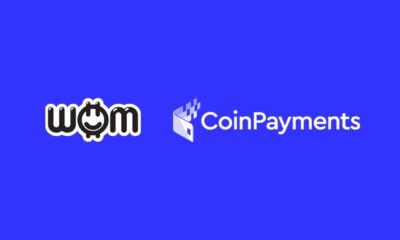
 Blockchain5 years ago
Blockchain5 years agoWOM Protocol partners with CoinPayments, the world’s largest cryptocurrency payments processor
-

 Press Release5 years ago
Press Release5 years agoETHERSMART DEVELOPER’S VISION MADE FINTECH COMPANY BECOME DUBAI’S TOP DIGITAL BANK
-
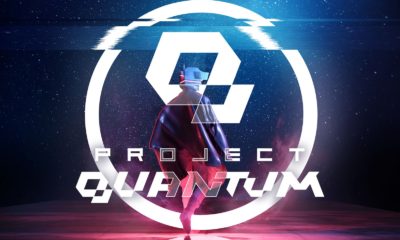
 Press Release5 years ago
Press Release5 years agoProject Quantum – Decentralised AAA Gaming
-

 Blockchain5 years ago
Blockchain5 years agoWOM Protocol Recommended by Premier Crypto Analyst as only full featured project for August
-

 Press Release5 years ago
Press Release5 years agoETHERSMART DEVELOPER’S VISION MADE FINTECH COMPANY BECOME DUBAI’S TOP DIGITAL BANK
-

 Blockchain6 years ago
Blockchain6 years ago1.5 Times More Bitcoin is purchased by Grayscale Than Daily Mined Coins

